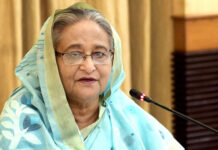We must try to restore the historic establishment to its former glory

Courtesy
April 18, 2022 Dhaka Tribune
Madhur Canteen is a familiar name in our history because of its association with various political movements originating at Dhaka University. The canteen played a pivotal role in the Bangladesh Independence Movement, was the focal point of all socio-cultural and political activities in the 1960s and 1970s, and even today continues to play the same role . Madhur Canteen is no less than Kolkata’s Coffee House in name and fame.
As part of Operation Searchlight, the Pakistan army targeted Madhur Canteen during its mayhem at Dhaka University on March 25-26, 1971. Madhusudan Dey (known as Modhu da), the canteen’s founder, was killed in the early minutes of March 26, 1971, at the beginning of the Bangladesh Liberation War.
The Pakistani military stormed his house and Dey’s wife, son and daughter-in-law were amongst those killed. Madhusudan Dey was injured in the firing, arrested, and taken to the Jagannath Hall playground by the Pakistani soldiers, where he was executed along with many university students.
One would be embarrassed to visit the canteen today for a cup of tea or to indulge in adda. The canteen lies in ruins. It looks as if it is a child without any guardian, wearing a gloomy, dilapidated look.
The walls have fallen apart and are smeared with graffiti and posters. The floor is dirty, the room poorly ventilated and poorly illuminated. There are about a dozen or so dirty chairs and tables made of wood or plastic, many of them unfit for use.
The manager sits on a dilapidated, dirty chair behind an equally dirty, broken cupboard, while flies and cockroaches swarm everywhere.
There will hardly be any politicians, academics, literary figures, poets, actors, bureaucrats, journalists, sports men, people from print and electronic media and from all walks of life who have not ventured into Madhur Canteen for a cup of tea/coffee or relished crispy samosa/piajyu /puri / shingara and other snacks and indulged in serious discussions/adda.
Nobody cares now. I was embarrassed when I visited the place after many years. Do we not have any social responsibilities? The students who used to visit the canteen in the 1960s and 1970s are today’s leading politicians, academics, journalists, businessmen, bureaucrats, poets, actors, literary figures, national celebrities and so- called intellectuals. The present generation also has a responsibility.
I have been told that the two circular buildings beside the Canteen were used for cultural activities. The canteen and the two circular buildings with immense architectural and heritage value now lie virtually in ruins. In my personal assessment, the entire restoration should not cost more than Tk15-20 lakh.
Is this a big amount? I would earnestly request public and private universities, government and private banks, multinational corporations, Grameen Bank, Brac, Rotary International, FBCCI, MCCI, print and electronic media, BGB, army, police, to name a few, to shoulder responsibilities and help restore the glory of Madhur Canteen. Let us try to preserve it. It is part of our national heritage. The premises certainly deserve better treatment.










Modur Canteen has been a historic site as a seat of many historic political events and personalities who may have left their marks in this place. Even before it had become Modur Canteen, this place had a momentous event taken place which had shaped the map of this Sub-continent. It has a special place and significance for all Bangladeshi.
However, since the building of Modur Canteen is within the property of the Dhaka University, and primarily used by the students of DU, my question is if it should not be the responsibility of the Dhaka University to maintain it and keep it functioning in good condition.